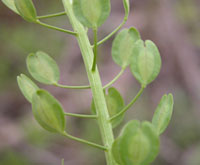 More farmers are growing weeds to harvest for biodiesel.
More farmers are growing weeds to harvest for biodiesel.
Some Midwestern farmers are just finishing their harvest of pennycress, a weed that produces about 20,000 seeds per plant that are composed of 36% oil, twice that of soybeans, and has a chemical composition that is ideally suited for conversion to biodiesel or green renewable jet fuel. An acre of pennycress can yield the equivalent of about 80 gallons of oil. This year the pennycress oil is priced similarly to soybean oil.
“I saw an opportunity to produce an energy crop here-and-now on underutilized assets with no negative impact to the environment or the farm,” said Peter Johnsen, who has been instrumental in commercialization of the crop. Johnsen is a retired director of the USDA’s National Center for Agricultural Utilization Research in Peoria, Ill. “A great benefit is that we can grow pennycress during the winter on existing farms that would otherwise just sit dormant. It has no impact on existing crops, conservation grounds, or critical wildlife habitat,” he said. Johnsen estimates there are potentially 40 million existing farm acres for it.
For growing pennycress, the best approach the team found is to drop the seeds from an airplane into standing corn in the fall. It germinates under the corn, and is harvested in early spring using a soybean combine, before soybeans are planted. It’s then crushed with conventional crushing equipment, and the meal has potential value as livestock feed.
The National Biodiesel Board is encouraged by the development of this new feedstock. “The diversity of fats and oils from which biodiesel can be made has always been one of its greatest strengths, and pennycress is a perfect example of how our industry is innovative and sustainable,” said Alan Weber, who runs the National Biodiesel Board’s feedstock development program.
There’s even a website devoted to growing pennycress as an energy crop – growpennycress.com.

